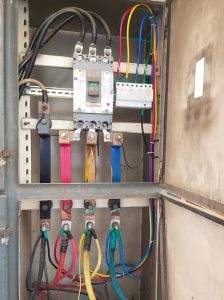What is an Earth Electrode?
Earth Rods are a type of Earth Electrode. An Earth Electrode is a conducting element buried directly in the ground, facilitating the flow of fault currents towards the ground. This means that Earth Electrodes are metallic and, since they have to be buried for long periods of time, they need to be resistant to corrosion as well. Earth Electrodes can come in a variety of materials, shapes, sizes, and arrangements including pipes, plates, a ring around the structure (known as Type B Earthing), or as an Earth Rod. These Rods are also commonly referred to as Ground Rods in North America. You can see Axis’s range of Earth Rods here or download our catalogue!
Types & Construction
| Type | Usage |
| Copper Bonded Earth Rods | The most cost-effective option while still providing corrosion resistance and low electrical resistance and the steel core makes it easier to be driven into the ground. |
| Solid Copper Earth Rods | Used in areas with high corrosion or in applications where exceptionally long life are needed. |
| Stainless Steel Earth Rods | Used where there may be issues caused by galvanic corrosion because of dissimilar metals buried close together. |
| Galvanised Steel Earth Rods | Low cost but also low electrical conductivity, current carrying capacity, and corrosion resistance. |
Talk to our engineers!
A) Solid Copper Earth Rods

They are one of the best choices for Earth Electrodes. They can be used in areas with high corrosion or in applications where an exceptionally long life is needed. They are also used in installations with high fault currents. These Solid Copper Rods are manufactured from Solid Copper bars and are then processed to enable jointing. These Solid Copper Rods however are not suitable for deep driving into the ground because of the possibility of bending and are additionally significantly more expensive than the other Rod options.
B) Copper Bonded or Copperbond Earth Rods

They are made using an electroplating process where a layer of Copper is deposited on a steel core. Copper Bonded products offer an advantage over copper-clad products because they are molecularly bonded with the steel core and will thus not slip or tear when they are driven into the ground. Copper Bonded Rods are also significantly more cost-effective than Solid Copper Rods while still providing corrosion resistance and low electrical resistance. Additionally, the steel core makes these Copper Bonded Rods more favourable to be driven into the ground.
Thus, Copper Bonded Rods provide high tensile strength using low carbon steel with molecularly bonded 99.9% pure electrolytic copper. This makes Copper Bonded Rods the most economically efficient and popular choice for Earth Rods around the world. Axis has more than 25 years of experience manufacturing and selling Copper Bonded Rods to utilities and other customers in more than 80 countries. Contact us to find out more about our products!
C) Stainless Steel Earth Rods

Stainless Steel Earth Rods offer functionality akin to our Solid Copper Rods but come with the added advantage of being more anodic. This feature makes them a preferred choice in environments where different types of metals are buried close to one another, minimizing the risk of galvanic corrosion. Though they tend to be on the pricier side compared to other options, their unique anti-corrosion properties make them a valuable choice for specialized applications.
D) Galvanised Steel Earth Rods

Galvanized Steel Earth Rods are constructed from high-strength, low-carbon steel and undergo a hot-dip galvanizing process. While they are the most cost-effective option available, it’s important to note that they offer limited corrosion resistance and possess lower electrical conductivity and current-carrying abilities.
Earth Rod Installation is an essential step of Lightning Protection, learn the basics here.
Benefits of Earth Rods
Earth Rods and their accessories provide high fault current capacity for LV, MV and HV substations, towers and other distribution applications. They can be used for both overhead and underground networks to achieve optimum earthing for distribution and transmission.
Earth Rods are one of the most popular Earth Electrodes used globally because:
- Copper Bonded Earth Rods are the most economical method of achieving a low earth resistance.
- They are easy to install in soil conditions that are free from rock and boulders. Copperbond Earth Rods provide high tensile strength using low carbon steel with molecularly bonded 99.9% pure electrolytic copper and thus can be easily driven into the ground with a driving rod hammer without needing to dig a large trench.
- They are designed to be extendable. Highly conductive copper couplers are used to join multiple rods together to achieve the desired length to access lower resistance soil deeper in the ground.
- When space is a constraint, vertically driven rods are a much more space-efficient method of earthing.
- They are corrosion-resistant.
- Their compact design makes them easy to store and transport over long distances.
You can view our wide range of Earth Rods in a variety of sizes here. You can contact us if you want a quotation or have any further questions regarding Axis Earth Rods.
This article is part of our series of articles on Lightning Protection, Surge Protection & Earthing, you can read more with the following links:
Surge Protection Devices (SPD)
Lightning Protection Zones and their Application to SPD Selection
How does a Lightning Arrester work?
For more information, please contact us at axis-india.com/contact-us/









